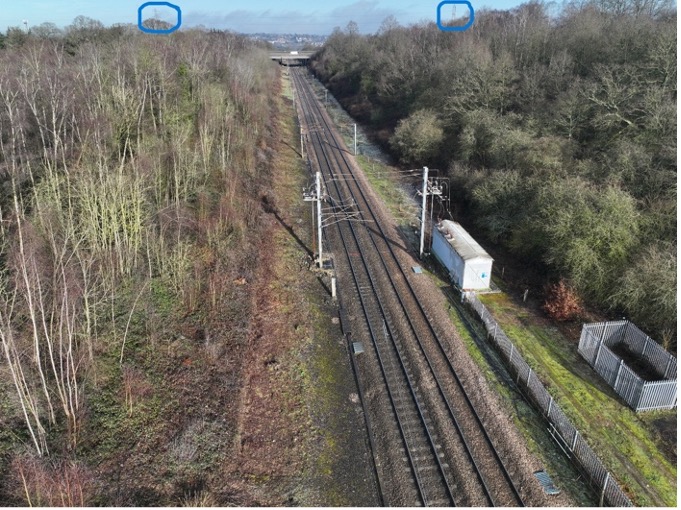The Charity
Aviation
Maritime
DUAS30
Initial Report
Performing Beyond Visual Line of Sight (BVLOS) flights with visual mitigation (observers positioned out along the flightline who are in touch with each other and the pilot) for the purpose of data capture, we flew through cabling between two pylons a total of 4 times and only noticed they were there when looking at the photographs after the flights. The pylons were obscured from the TOAL site because we were in a cutting. We had previously flown an adjoining section of the same infrastructure in the opposite direction and the pylons at the end point of the two sections were obscured from the TOAL at both ends of each section, even if the aircraft always remained VLOS. The electricity cables were across the infrastructure rather than parallel with it. This meant they were much more difficult to see. The first photo I attach is a general view from aircraft. The pilots were located on the right-hand side, away from the track. There was little visibility of the cables that were across the track and the pylons were obscured from view. The previous flight was flown towards the road bridge, from the far end. The cables were between 30 and 45m high and crossed over this side of the road bridge. The second photo is an approximately 11X zoomed picture looking under the road bridge.
Lessons learned: When checking for electric cables, it is not sufficient to just look for pylons alone. Electric cables are difficult to see and the site inspection should include the start and end point.


CHIRP Comment
As the CAA has recently launched a consultation on Atypical Air Environment, this is a particularly well-timed report. When flying linear infrastructure for the purpose of data capture, identifying ground control points, image overlap, on-board data-storage capacity and data-block sizes for delivery are all primary considerations in establishing site work methodology. This means that, on occasion, several flights might take place where they are flown in opposite directions towards each other.
The end point of two flights that meet in the middle but are flown in opposite directions, may inadvertently end up not being subject to on-site visual inspection by the pilot. Pylon cables are difficult to see with the naked eye, particularly if they are at some distance. This report shows how easy it is to mistakenly fly through unseen wires when the pilots are concentrating on the output, rather than the flights. This occurrence is all about the lack of real pre-flight planning. Closer attention to relevant Apps that supply all the information for low-level flying is essential and a focus on the detail as well as ensuring the relevant layers are switched on, would have avoided this situation.